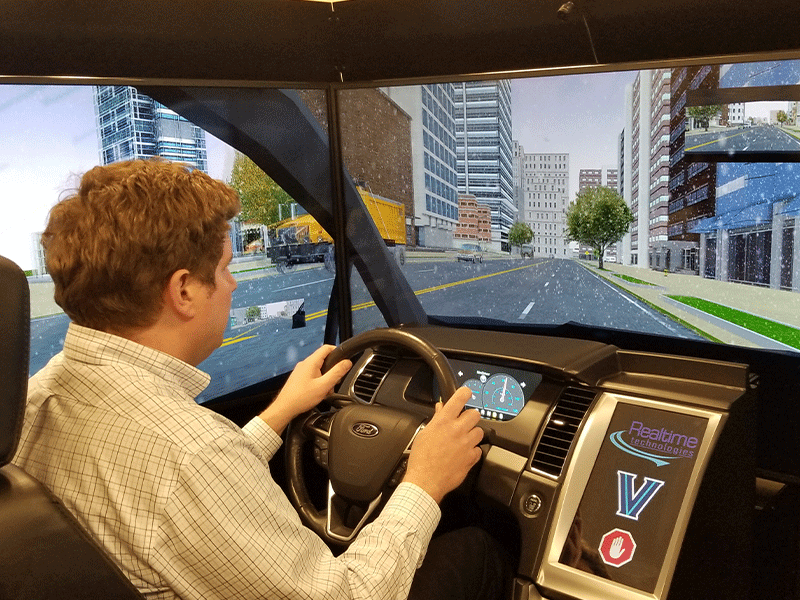Elucidating the Brain-Behavior Connection to Improve Driver Safety

Research Associate Professor of Electrical and Computer Engineering Dr. Meltem Izzetoglu has spent her career collaborating on myriad biomedical research projects, many of which tend to unfold concurrently. For example, she has been involved in a study with Albert Einstein College of Medicine for over ten years exploring cognitive aging, specifically how tasks like walking are affected by changes in cognition, which affect many older adults with conditions like diabetes, MS, and Parkinson’s.
An expert in brain imaging, she leads the Biomedical Signals, Systems and Analysis Laboratory (Bio-SSA Lab) at Villanova, which focuses on studying how the human body and brain function together. One active area of research and development in her lab is the use of fNIRS (functional near infrared spectroscopy) to elucidate the brain-behavior connection. Dr. Izzetoglu explains, “With fNIRS, we can monitor non-invasively. Light sources and detectors are placed on the forehead, allowing certain wavelengths to penetrate the head and give you information about oxygenation levels in the brain.” By measuring changes in oxygenation levels over time, she is able to assess “what is going on in the brain, be it lack of concentration, focus or fatigue.” In addition to its affordability and high-fidelity, another positive feature of the fNIRS technology is that you can use it while doing everyday tasks. She is developing a miniaturized version that is akin to a band-aid and gets placed on one’s forehead, with applications spanning attention through performance.
Having pioneered fNIRS applications in bio-medical diagnostics and monitoring, Dr. Izzetoglu now turns her attention to this technology’s application within the training space, specifically driving simulation training. Dr. Izzetoglu has an ongoing research collaboration with her colleague Dr. Seri Park, Clare Boothe Luce Associate Professor, Civil and Environmental Engineering, who specializes in transportation engineering. Their collaboration began in the summer of 2020, co-advising a student-led INNOVATE team (click here for more information on the INNOVATE program) on the development of a new driving simulator platform that could provide realistic driving scenarios for a fraction of the cost of current high-end models. Their prototype was built using common gaming software and incorporates a consumer-grade Augmented Reality headset, balancing affordability with performance. The long-term goal was to integrate fNIRS into the platform so that it could serve as a training tool for new drivers and as a means to assess dangerous driving behavior in older populations.
Dr. Izzetoglu will be assisting Dr. Park as she launches the first phase of a two-part study on driver behavior, with a particular focus on how distracted driving affects decision making and performance behind the wheel. This study will make use of the RDS-1000, a high end, state-of-the-art driving simulator that is housed within Dr. Park’s Transportation Simulation Lab. The fully immersive system includes a steering wheel, accelerator, brake pedal, and surround-sound audio system, along with a virtual dashboard and three wide screen LCD monitors that provide 150 to 210-degree field of view. The first phase of the study is funded by the National Motorists Association and Dr. Park is the Principal Investigator with collaborators from the University of Texas, Arlington. The second part of the study was funded through the Catalyst Phase of the National Academy of Medicine Healthy Longevity Global Competition and the University of Texas, Arlington is the lead institution. Fifty young adults who recently learned to drive will be recruited for phase one and fifty older adults will be recruited for the second phase.
The integration of the driving simulation software with tracking and imaging technology is likely to produce novel insights into the brain-behavior connection. Among the questions the research teams are looking to answer is how much an effect distracted and/or drowsy driving has on cognition levels and performance among these two distinct groups of drivers. Dr. Park’s eye-tracking technology and Dr. Izzetoglu’s wireless wearable sensors will be used to assess the participants’ levels of concentration or distraction. Dr. Izzetoglu notes, “The origin of every behavior is in the brain. So is there something that happens first [cognitively] that you can monitor and use that is connected to the behavioral outcomes?” If so, the implementation of fNIRS and related imaging technologies in virtual training scenarios could be invaluable in its ability to shed light on this important issue. Perhaps it could even predict declines in driving performance, leading to less dangerous drivers on the road, which could result in fewer accidents over time.
